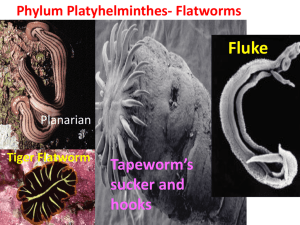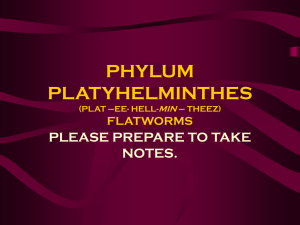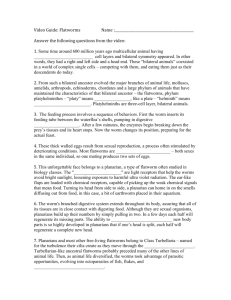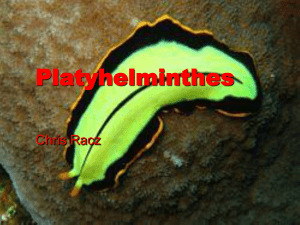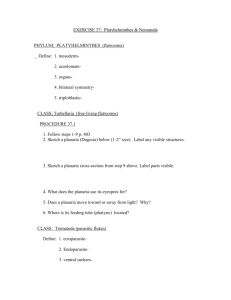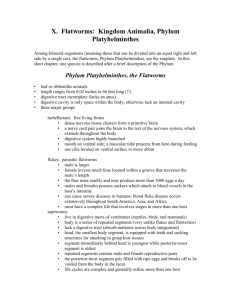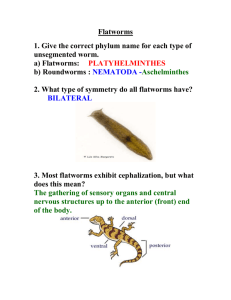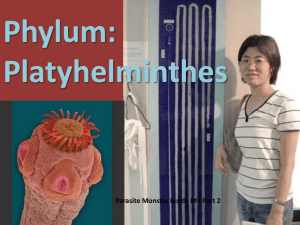Flatworms
advertisement
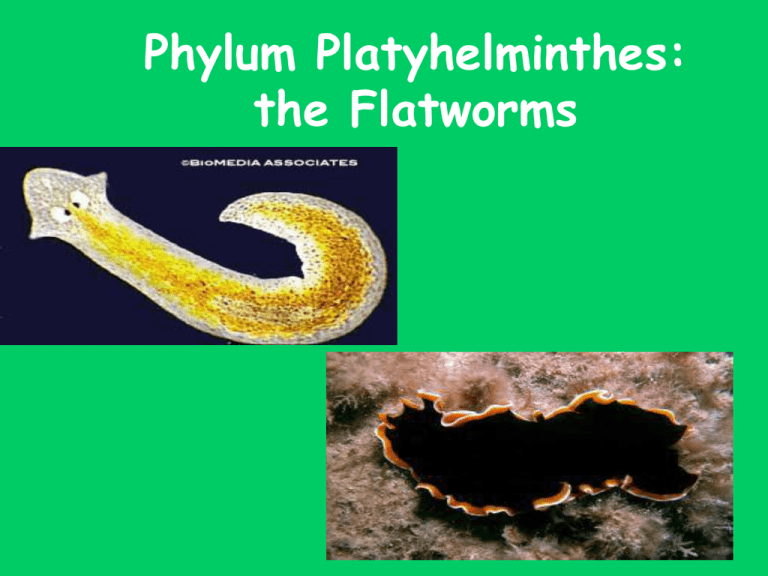
Phylum Platyhelminthes: the Flatworms Platyhelminthes Vocabulary Use the blue modern bio textbook to do these on your grid. Color should be on front. It doesn’t matter how you write the back. Remember to complete your squares and # them correctly on the back. 1. Pharynx 2. Flame Cell 3. Cerebral ganglion 4. Eyespot 5. Fluke 6. Tegument 7. Primary host 8. Scolex 9. Cyst 10. Proglottid 11. Schistosomiasis 13. Strobila the body of a tapeworm EXCLUSIVE of the head 12. Intermediate host and neck region Taxonomy Kingdom: Animalia Phylum:Platyhelminthes (Plat = flat) Class Turbellaria Class Trematoda Class Cestoda Intro to Flatworms http://www.youtube.com/watch?v=w0QzSYQGsnA http://www.youtube.com/watch?v=ol5w-RlDuQ4 Characteristics of Flatworms • They are acoelomates (they don’t have body cavities) • They have bilateral symmetry • Show cephalization • Single opening to digestive tract (pharynx) – Protostomes Characteristics cont. • Simplest animals to have 3 germ layers. • Triploblastic • Because they are flat, all cells are close to the animal’s external surface. • All flatworms rely on diffusion for: • respiration • excretion • circulation. Characteristics cont . Digestive System • Most parasitic worms do not need a complex digestive system…WHY? • They obtain nutrients from foods that have already been digested by their host. Excretory, Nervous, and Reproductive Structures of a Planarian Ganglia DRAW THIS!!! Nerve cords Excretory system Flame Cells maintain water balance (osmoregulation) and remove waste Ovary Testes Flame cell Copyright Pearson Prentice Excretory tubule Hall Movement • Free-living flatworms move in two ways: • Cilia on their epidermal cells help them glide through the water and over the bottom of a stream or pond. • Muscle cells controlled by the nervous system allow them to twist and turn. *The development of directional movement is correlated (works in relation) with cephalization. -some members have light sensitive receptors in head region called ocelli -in other members there are chemoreceptors & balance receptors that sense water movement (not all in head region) Review Questions • 1. What phylum are flatworms part of? • 2. What are the three classes of flatworms? • 3. What type of coelomate are flatworms? Name and describe. • 4. How do they breathe? • 5. What type of cells remove waste? Class Turbellaria • FreeLiving flatworms – Examples are planarians • Eat protozoans http://www.youtube.com/watch?v=Fq_aSR5FK0Y&fea ture=related Planarians – Nervous System • Spade-shaped at the anterior end • Have two, light-sensitive eyespots (ocelli) – Can sense light, touch, taste, & smell Planarians – Nervous System • Have 2 clusters of nerve cells or ganglia to form a simple brain • Nervous system composed of a nerve net Reproduction • Sexual Reproduction -Hermaphrodites Cross fertilize eggs (Penis Fencing = can last up to an hour; sperm delivered (injected) anywhere on mate’s body; recipient of sperm become the mother) • Asexual Reproduction by Regeneration Planaria regeneration pt 1 Planaria regeneration part 2 Class Trematoda • Are parasitic flukes • Have suckers on both ends – to cling to host & suck blood, cells, & body fluids • Can live inside or outside of host (endo/ectoparasite) Liver Fluke Class Trematoda • Nervous and excretory systems like turbellarians • Hermaphrodites • Have complex life cycles – Require 2 hosts (intermediate/primary) Schistosome FLUKE ANATOMY http://www.youtube.com/watch?v=uFQw- #5 What 2 names are given for disease caused by schistosome? http://www.youtube.co m/watch?v=0xOO7e6t SzE liver fluke Example Schistosomiasis • Disease caused by a parasitic blood fluke called a Schistosome. • Infects people in Asia, Africa, & South America causing intestinal bleeding & tissue decay that can result in death. (unsanitary living conditions) http://www.youtube.com/watch?v=VnlYUe57Lr0&featur e=related Schistosomiasis Schistosomiasis • http://www.youtube.com/watch?v=Hkqk5Ljc3ko • http://www.youtube.com/watch?v=cS70xQ5OywI • http://www.youtube.com/watch?v=kIwVRhvk2oM&feature=relat ed • http://animal.discovery.com/tv-shows/monsters-insideme/videos/inside-a-snail-fever-lab.htm Schistosomiasis (video notes) • Caused by blood fluke – Schistosome • Infects blood vessels around the host’s bladder and reproduces rapidly • Excreted in the urine & can come in contact with skin • Starts as eggs in freshwatergrows in snailwaterhuman • Creates a red rash if eggs are lodged in the skin • Massive buildup in tissue can cause cancer • 200,000,000 world wide..many in Africa • Snail-intermediate host • Human-primary host • If infected, you are susceptible to get worm again even after treatment • Unsanitary water – Global disease #4 • The flukes are attracted to the fatty acid in the skin • Can go undetected for 20 years White Tail Deer Liver Fluke http://www.youtube.com/watch?v=NXNrsJlhrFk Fluke Case Japanese Lung Japanese Lung Fluke • Burrows into lung tissue and begins laying eggs • Causes response of severe coughing up of blood and release of body fluids • Can be transmitted through raw crabs • 80% of freshwater crabs in Asia are infected • Causes inflammation in the lungs • Blood that is coughed up is filled with eggs • It is then reswallowed and excreted in feces • Has many intermediate hosts • Coughing up blood is a major sign of infestation Review Questions • • • • 6. Which class is made up of flukes? 7. Where can flukes live? 8. Why do they have suckers? 9. What does hermaphrodite mean? Class Cestoda • About 2,000 species • Parasitic Tapeworms • Long, ribbon-like bodies • No digestive system • Absorbs nutrients from host • Hermaphrodites • Can live in intestines of almost almost all vertebrates • Humans can harbor any of SEVEN different species • Tapeworm may cause: digestive problems, weight loss, lack of energy, and anemia (decrease in # of RBCs) Different from other flatworms because they… • Lack eyespots and other light sensitive structures • Have no mouth/pharynx – Instead they have hooks & suckers • No Gastrovascular cavity • No other digestive organs SCOLEX of the tapeworm Reproduction •Proglottids are the segments that make up most of the worm's body. •Mature proglottids contain both male and female reproductive organs. Scolex Tapeworm Anatomy Young proglottids Mature proglottids Uterus Zygotes Testes Ovary Reproduction cont • Mature proglottids are released in excrement (feces). • Eggs are ingested by grazing animals • Eggs hatch into larva • Larva infect muscle tissue of animal and form cysts • Humans can become infected by eating undercooked meat. Tapeworm life cycle Pork Tapeworm TAPEWORMS • http://www.youtube.com/watch?v=txSi ApFzaZE overview • http://animal.discovery.com/tvshows/monsters-inside-me Pork Tapeworm • http://animal.discovery.com/tvshows/monsters-inside-me/videos/porktapeworm-in-brain.htm End of PP. review questions. 5. How do livestock ingest tapeworm eggs? 6. Where do tapeworm larvae form cysts? 7. Cysts can survive in _____ or ________ meat. 8. Where does the tapeworm attach itself? Platyhelminthes REVIEW QUESTIONS Flatworms are the simplest animals to have a. two germ layers. b. bilateral symmetry. c. radial symmetry. d. two openings in the digestive system. An individual that has both male and female reproductive organs is known as a. turbellarian. b. proglottid. c. hermaphrodite. d. parasite. The function of flame cells in flatworms is to: a. digest food and move it to various parts of the body. b. detect the presence of chemicals in the surroundings. c. remove excess water and metabolic wastes d. move reproductive cells into position for fertilization. A flatworm that lacks a digestive tract is the a. planarian. b. free-living flatworm. c. tapeworm. d. fluke. Turbellarians differ from most other flatworms because they a. b. c. d. live freely on land. live freely in fresh and salt water. are marine parasites. are land-dwelling parasites. 6. The eyespots of a planarian can be found at the _. • Base of the organism • Anterior end of the organism • Posterior end of the organism • In the gut 7. Which of the following is a parasitic flatworm that causes inflammation in the lungs? • Planarian • Fluke • Tapeworm 8. _ on the epidermal cells of flatworms help them glide & move. • Flame cells • Muscle cells • Cilia 9. What major organ in a human is able to regenerate? • Heart • Brain • liver 10. What flatworm is aiding in the research of stem cells? • Fluke • Planarian • Tapeworm • 11. Which of the following is NOT a class of Platyhelminthes? Cestoda • Agnatha • Trematoda • Turbellaria Foldable 1. Take a sheet of paper and cut in half. 2. Lay one sheet on the other and offset by ~ 1/2 inch. 3. Fold in the middle to form 4 tab booklet. 4. Staple the top. 1 2 3&4 1. Label the tabs as shown. 2. Under each tab List the following and answer for each: 1. 2. 3. 4. 5. 6. 7. 8. Example: Coelom: Symmetry: Germ Layers: Digestive System: Nervous System: Reproduction: Habitat: Phylum Platyhelminthes Class Turbellaria Class Trematoda Class Cestoda
